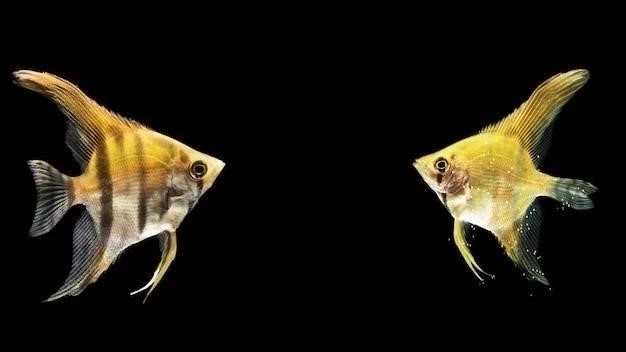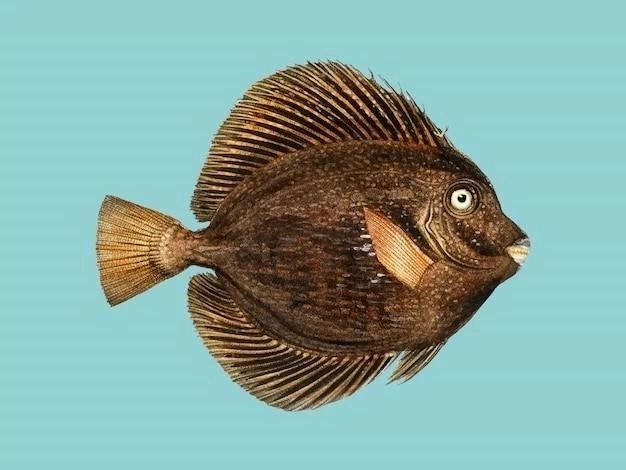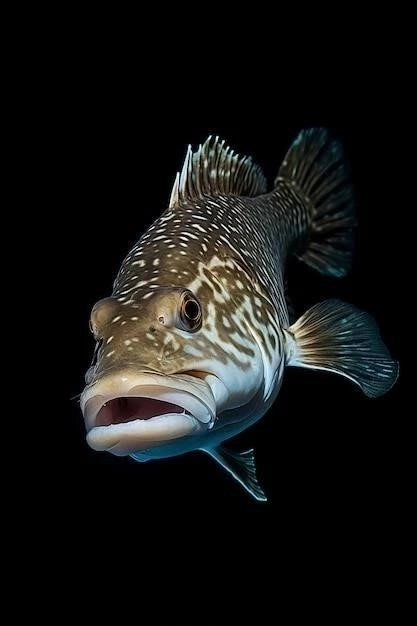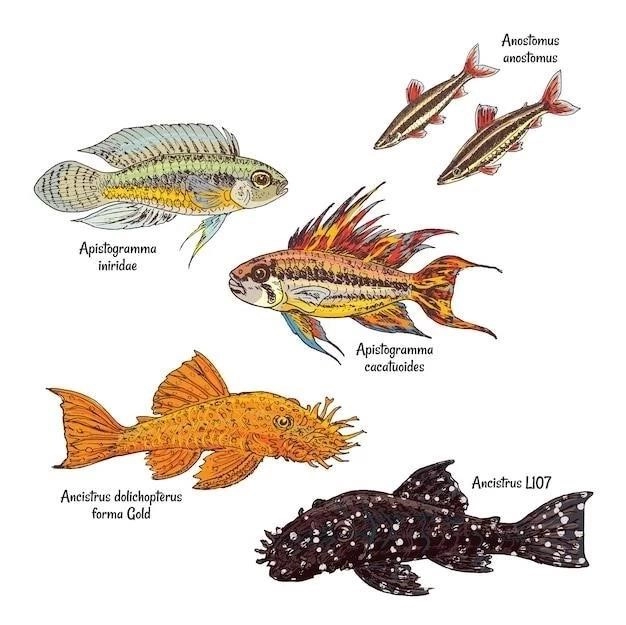Physical Characteristics
Deep-sea anglerfish are uniquely adapted to their environment. They possess a rotund, laterally compressed body, often with soft bones and scales reduced or absent. This physique, while seemingly clumsy, is ideal for conserving energy in the low-food environment of the deep. Their coloration varies, typically ranging from grays to dark browns, providing camouflage against the seafloor and water column. Anglerfish mouths are disproportionately large, with sharp, inward-pointing teeth, facilitating the capture and swallowing of prey larger than themselves.

Habitat and Distribution
Anglerfish, encompassing a diverse group within the Lophiiformes order, exhibit a remarkable range of habitat preferences, from shallow coastal waters to the profound depths of the abyssal zone. This ecological diversity highlights the adaptive success of these fascinating creatures.
Deep-Sea Dwellers:
The majority of anglerfish species, particularly those belonging to the suborder Ceratioidei, have carved their niche in the deep sea, a realm characterized by perpetual darkness, crushing pressure, and scarce food resources. These deep-sea denizens are typically found at depths exceeding 1,000 meters, with some species venturing as deep as 4,000 meters or more. Within this extreme environment, anglerfish inhabit a variety of benthic and pelagic zones, lurking among rocky outcrops, clinging to the seabed, or drifting passively in the water column.
Coastal and Shelf Adaptations:
While the deep sea remains the anglerfish’s primary domain, certain species have successfully colonized shallower, more accessible waters. For instance, members of the Antennariidae family, commonly known as frogfish, are often encountered in tropical and subtropical coral reefs, where they utilize their camouflage and uncanny resemblance to sponges or rocks to ambush unsuspecting prey. Similarly, some anglerfish species inhabit temperate coastal shelves, adapting to a wider range of temperatures and depths.
Global Distribution:
Anglerfish exhibit a global distribution, with species found in every ocean basin, from the frigid waters of the Arctic and Antarctic to the warm, tropical seas. Their widespread presence underscores their adaptability and ecological success in a variety of marine environments. However, the distribution of specific species is often influenced by factors such as water temperature, depth, prey availability, and the presence of suitable spawning grounds.
Factors Influencing Distribution:
The distribution of anglerfish, particularly in the deep sea, is often patchy and influenced by the availability of food and suitable mates. The deep-sea environment, with its limited resources, presents significant challenges for finding sustenance and reproducing. As a result, anglerfish have evolved unique adaptations, such as bioluminescent lures and extreme sexual dimorphism, to overcome these obstacles.
Despite their widespread distribution, the deep-sea environment, with its inherent inaccessibility, makes studying anglerfish populations a challenging endeavor. Much remains to be discovered about the distribution patterns, population densities, and long-term ecological trends of these enigmatic creatures. As deep-sea exploration technologies advance, scientists hope to gain a more comprehensive understanding of anglerfish populations and their role in the deep-sea ecosystem.

Hunting and Diet
The anglerfish’s hunting strategy and diet are a testament to the ingenious adaptations that have allowed these creatures to thrive in the challenging depths of the ocean. Their hunting techniques center around a unique combination of stealth, patience, and a specialized anatomical lure that exploits the darkness of their environment.
The Alluring Trap:
The most distinctive feature of the anglerfish, and the key to its hunting success, is its bioluminescent lure, known as the esca or illicium. This modified dorsal spine, located above the anglerfish’s mouth, houses bioluminescent bacteria that emit an eerie, alluring glow in the darkness of the deep sea. The esca acts as an irresistible beacon, drawing in unsuspecting prey from the surrounding gloom.
Masters of Deception:
Anglerfish are masters of deception, employing a variety of techniques to enhance the effectiveness of their lures. Some species can control the intensity and flashing pattern of their esca, mimicking the movements of smaller organisms to entice prey. Others possess elaborate, fleshy appendages surrounding their mouths that resemble worms or crustaceans, further enhancing their camouflage and luring unsuspecting victims within striking distance.
A Diet of Opportunity:
The anglerfish’s diet is as diverse as its habitat, reflecting the opportunistic nature of these predators. In the food-scarce environment of the deep sea, anglerfish have evolved to consume a wide variety of prey, ranging from small invertebrates like crustaceans and squid to larger fish, sometimes even exceeding their own size. Their large mouths, sharp teeth, and expandable stomachs allow them to consume prey much larger than themselves, maximizing their chances of survival in an environment where meals are often few and far between.
The Art of the Ambush:
Anglerfish are ambush predators, relying on patience and camouflage rather than speed or agility to capture their prey. Their sedentary lifestyle, coupled with their cryptic coloration and body shapes that blend seamlessly with their surroundings, allows them to lie in wait, virtually invisible to unsuspecting prey. When a potential meal ventures close enough, the anglerfish strikes with lightning speed, its large mouth engulfing its victim in an instant.
Adaptations for Survival:
The anglerfish’s hunting strategy and diet are a testament to the evolutionary pressures of the deep-sea environment. Their unique adaptations, from their bioluminescent lures to their expandable stomachs, highlight the remarkable ways in which life has found a way to thrive in one of the planet’s most extreme and unforgiving habitats.

Bioluminescence and the Illicium
The deep-sea anglerfish, inhabiting a world of perpetual darkness, has evolved an ingenious adaptation that sets it apart from almost all other creatures: bioluminescence. This remarkable ability to produce light, coupled with the unique structure of the illicium, makes the anglerfish a formidable predator in the depths.
The Light in the Darkness:
The source of the anglerfish’s ethereal glow lies not within its own cells but in a symbiotic relationship with bioluminescent bacteria. These bacteria reside within a specialized organ called the esca, located at the tip of the illicium, a modified dorsal spine that protrudes from the anglerfish’s head like a fishing rod. The esca acts as a miniature, self-contained bioluminescent bulb, emitting a cold, blue-green light that pierces the surrounding darkness.
A Mutually Beneficial Partnership:
The anglerfish and its bacterial symbionts have evolved a mutually beneficial relationship. The anglerfish provides the bacteria with a safe haven and a steady supply of nutrients, while the bacteria, in turn, provide the anglerfish with its vital bioluminescent lure. This symbiotic partnership highlights the intricate interplay between different life forms in the deep sea.
The Alluring Dance of the Illicium:
The illicium, much like a fishing rod, can be moved and manipulated with remarkable dexterity. Anglerfish can vary the intensity and flashing patterns of their esca, mimicking the movements of smaller organisms to entice unsuspecting prey. This alluring dance of light, coupled with the esca’s resemblance to a small, injured fish or invertebrate, proves irresistible to many deep-sea dwellers, drawing them towards the anglerfish’s patiently waiting jaws.
Variations on a Theme:
The structure and placement of the illicium vary considerably among anglerfish species, reflecting the diversity of their prey and hunting strategies. Some species possess long, whip-like illicium that extend far out from their bodies, while others have shorter, more robust illicium located closer to their mouths. The esca itself can range in shape from a simple bulb to elaborate, fleshy appendages resembling worms or crustaceans, further enhancing their alluring mimicry.
A Beacon in the Abyss:
The anglerfish’s bioluminescent illicium is a testament to the power of natural selection in shaping extraordinary adaptations. In the darkness of the deep sea, where light is a precious and often deceptive commodity, the anglerfish’s bioluminescent lure serves not only as a tool for hunting but also as a potential means of communication and species recognition in a world where encounters are rare and fleeting.

Reproduction and Sexual Dimorphism
The deep-sea anglerfish exhibits one of the most extreme examples of sexual dimorphism in the animal kingdom, a testament to the extraordinary adaptations that arise in response to the challenges of survival and reproduction in the abyssal depths.
A World of Unequal Encounters:
In the vast, sparsely populated abyssal plains, encounters between male and female anglerfish are exceedingly rare. This scarcity of potential mates has driven the evolution of a remarkable reproductive strategy, one characterized by extreme size differences between the sexes and a unique form of parasitic mating.
The Dwarfed Male:
Male anglerfish are dwarfed in comparison to their female counterparts, often by an order of magnitude. While females can reach sizes of up to a meter in length, males may only grow to a few centimeters. This extreme size disparity reflects the male’s singular purpose: to locate and attach to a female, ensuring the continuation of their genes.
A Parasitic Bond:
Upon locating a female, often guided by powerful pheromones released into the water, the male anglerfish will attach himself to her body using his sharp teeth. This attachment is not merely a temporary embrace; it marks the beginning of a lifelong parasitic bond. The male’s tissues fuse with the female’s, and he loses his eyes, fins, and most internal organs, essentially becoming a living sperm bank for the female.
A Lifetime of Nourishment and Reproduction:
The female anglerfish, in turn, provides the attached male with a continuous supply of nutrients through her bloodstream, ensuring his survival and the availability of sperm for fertilization. A single female may carry multiple males attached to her body, providing a reproductive advantage in an environment where encounters with potential mates are few and far between.
The Mystery of Egg Fertilization:
The exact mechanisms of egg fertilization in anglerfish remain shrouded in mystery. Some scientists speculate that females release eggs into the water column, where they are fertilized by sperm released from the attached males. Others hypothesize that fertilization may occur internally, with the female using sperm stored from her attached mate. Further research is needed to fully unravel the complexities of anglerfish reproduction.
The anglerfish’s extraordinary reproductive strategy, characterized by extreme sexual dimorphism and parasitic mating, highlights the lengths to which life will go to ensure survival in one of Earth’s most challenging environments. Their bizarre and fascinating life cycle continues to captivate scientists and ignite our imaginations about the hidden wonders of the deep sea.

Adaptations to the Deep Sea
The deep sea, a realm of perpetual darkness, crushing pressure, and scarce resources, presents a formidable challenge to life. Yet, the anglerfish, through a suite of remarkable adaptations, not only survives but thrives in this extreme environment, a testament to the power of natural selection.
A Body Built for the Abyss:
Anglerfish possess a unique morphology perfectly suited to the deep-sea environment. Their soft, flabby bodies, often lacking scales or possessing reduced, embedded ones, minimize bone and muscle mass, conserving energy in a world where food is scarce. Their large heads, disproportionately sized mouths, and expandable stomachs allow them to consume prey much larger than themselves, capitalizing on infrequent feeding opportunities.
Bioluminescence: The Ultimate Lure:
Perhaps the anglerfish’s most iconic adaptation is its bioluminescent lure, the esca, located at the tip of the illicium. In the perpetual darkness of the deep sea, this glowing lure serves as an irresistible beacon, attracting prey from afar. The ability to control the intensity and flashing patterns of the esca further enhances its effectiveness, mimicking the movements of smaller organisms and luring unsuspecting victims within striking distance.
Sensing Vibrations in the Dark:
With limited visibility in the deep sea, anglerfish have evolved alternative sensory systems to navigate their surroundings and detect prey. Lateral lines, a series of sensory pores along their bodies, allow them to detect subtle changes in water pressure, alerting them to the movements of nearby organisms. This heightened sensitivity to vibrations helps them locate prey and avoid potential predators in the darkness.
A Slow, Deliberate Existence:
Conserving energy is paramount in the deep sea, where food is scarce and metabolic rates are slow. Anglerfish have adopted a sedentary lifestyle, relying on their camouflage and bioluminescent lures to attract prey rather than actively pursuing it. Their reduced musculature and slow metabolisms minimize energy expenditure, allowing them to survive for extended periods between meals.
Extreme Pressure, No Problem:
The crushing pressure of the deep sea, hundreds of times greater than at the surface, poses a significant challenge to most organisms. Anglerfish, however, have evolved specialized proteins and cellular structures that prevent their bodies from collapsing under the immense weight of the water column. Their flexible skeletons and lack of swim bladders further enhance their ability to withstand extreme pressure changes.
The anglerfish’s remarkable adaptations, from its bioluminescent lure to its pressure-resistant body, highlight the extraordinary diversity of life on Earth and the ingenious solutions that have evolved in response to even the most extreme environmental challenges. Their existence serves as a reminder that the deep sea, far from being a barren wasteland, teems with life, albeit life that often takes on strange and wonderful forms.

Swimming and Energy Conservation
In the deep sea, where food is scarce and encounters with prey are infrequent, energy conservation is paramount for survival. The anglerfish, through a combination of morphological adaptations and behavioral strategies, has evolved an energy-efficient lifestyle that allows it to thrive in this challenging environment.
A Body Not Built for Speed:
Unlike many fish that rely on speed and agility to hunt or evade predators, anglerfish are not known for their swimming prowess. Their rotund bodies, reduced musculature, and lack of swim bladders make them relatively slow and inefficient swimmers. This seemingly disadvantageous physique is, in fact, a key adaptation for conserving energy in the food-limited depths.
The Art of Efficient Locomotion:
Instead of relying on sustained swimming, anglerfish have adopted a more leisurely approach to movement. They primarily utilize a combination of fin propulsion and buoyancy regulation to navigate their surroundings. Their pectoral fins, often modified into limb-like appendages, allow for precise maneuvering and substrate-based locomotion, while their dorsal and anal fins provide stability and control.
Ambush Predators, Conserving Energy for the Kill:
Anglerfish are ambush predators, relying on stealth and deception rather than speed or agility to capture their prey. Their sedentary lifestyle, coupled with their cryptic coloration and bioluminescent lures, allows them to lie in wait, expending minimal energy until a potential meal ventures within striking distance. This energy-efficient hunting strategy maximizes their chances of survival in an environment where meals are often few and far between.
Minimizing Metabolic Demands:
In addition to their physical adaptations, anglerfish have also evolved physiological mechanisms that minimize their metabolic rates, further conserving energy. Their slow heart rates, reduced muscle activity, and low body temperatures reduce their overall energy expenditure, allowing them to survive for extended periods between meals. This remarkable ability to regulate their metabolism is crucial for survival in the deep sea, where food is scarce and opportunities for foraging are limited.
The Importance of Buoyancy Control:
While lacking a swim bladder, some anglerfish species utilize other means of buoyancy control to maintain their position in the water column with minimal effort. By adjusting their body fluids and lipid content, they can fine-tune their buoyancy, conserving energy that would otherwise be expended on constant swimming. This precise control of their buoyancy allows them to conserve precious energy for essential activities like hunting and reproduction.
The anglerfish’s remarkable adaptations for swimming and energy conservation exemplify the ingenious solutions that evolution can produce in response to environmental challenges. Their ability to thrive in the energy-limited depths of the ocean underscores the intricate interplay between morphology, physiology, and behavior that shapes life in this extreme environment.

Types of Anglerfish
The term “anglerfish” encompasses a diverse group of fishes belonging to the order Lophiiformes, with over 200 species distributed across 11 families. This remarkable diversity is reflected in their wide array of shapes, sizes, colors, and adaptations, each tailored to their specific ecological niche.
Deep-Sea Anglerfish (Ceratioidei):
The most iconic and perhaps bizarre of the anglerfish are those belonging to the suborder Ceratioidei. These deep-sea denizens are renowned for their extreme sexual dimorphism, bioluminescent lures, and parasitic mating behavior. Females, typically larger and more robust, possess the characteristic illicium with its glowing esca, while males are often dwarfed and may live their adult lives parasitically attached to females.
Goosefish (Lophiidae):
Goosefish, members of the family Lophiidae, are large, bottom-dwelling anglerfish found in shallower waters compared to their deep-sea counterparts. These ambush predators possess broad, flattened bodies, mottled camouflage, and a lure-like appendage on their snouts to entice prey. Unlike deep-sea anglerfish, goosefish do not exhibit extreme sexual dimorphism, with males and females being relatively similar in size.
Frogfish (Antennariidae):
Frogfish, belonging to the family Antennariidae, are masters of camouflage, often resembling sponges, algae, or rocks. They inhabit shallow, tropical and subtropical waters, particularly coral reefs, where they lie in wait for unsuspecting prey. Frogfish possess a highly modified illicium, resembling a small, fleshy appendage that they use to lure prey towards their large mouths. They are also capable of rapid bursts of speed, using jet propulsion to capture prey or escape predators.
Sea Toads (Chaunacidae):
Sea toads, members of the family Chaunacidae, are small, globular anglerfish with short, stubby illicium and bioluminescent lures. They inhabit deep-sea environments and are characterized by their loose, flabby skin and the presence of numerous sensory papillae on their bodies, which help them detect prey and navigate their surroundings in the darkness.
Batfishes (Ogcocephalidae):
Batfishes, belonging to the family Ogcocephalidae, are benthic dwellers found in tropical and subtropical waters. They possess flattened bodies, often with elaborate dermal appendages and coloration that provide camouflage on the seafloor. Batfishes have a small, highly modified illicium located in a groove between their eyes, which they use to attract prey. Unlike many anglerfish, batfishes are relatively poor swimmers, relying on their camouflage and lures to ambush prey.
This brief overview highlights the remarkable diversity within the anglerfish order. From the depths of the abyssal plains to the vibrant coral reefs, these fascinating creatures showcase the power of adaptation and the remarkable ways in which life has diversified to thrive in virtually every corner of the ocean.










